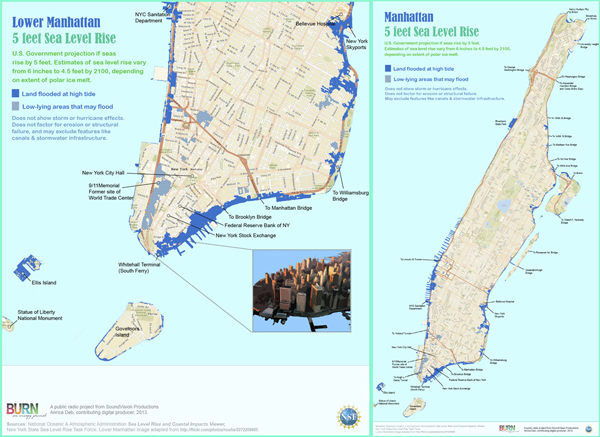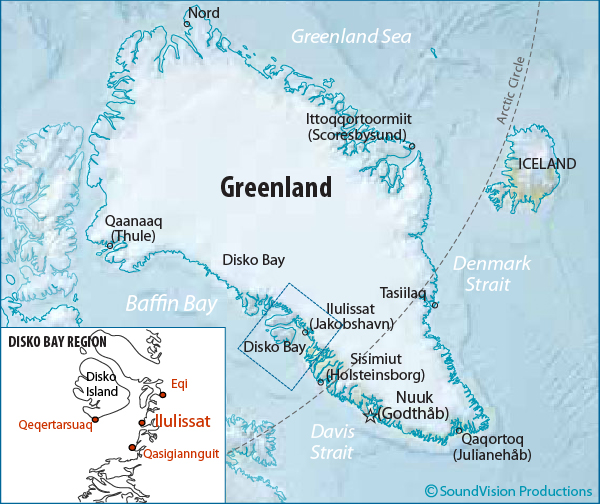Burn - An Energy Journal: Rising Seas
Duration: 54 mins
SBU investigator Malcolm Bowman is referenced at approximately 44 minutes 20 seconds into the broadcast and begins speaking soon after
Throughout October 2013,
BURN: An Energy Journal—a partnership that includes support from American Public Media, Marketplace Radio and PBS Newshour—began running a radio and Web series on "
Rising Seas." The inspiration behind the project comes from host Alex Chadwick, a reporter and writer who has come to the conclusion that Energy, and what to do about it, may be the defining issue of our time.

In his introduction of the series, Chadwick says, "Sea level rise has become the ugly face of climate change. The Organization for Economic Cooperation and Development has listed the 20 most threatened coastal cities in the world—Miami is first, New York is third, and New Orleans is 12th."
This "Rising Seas" special examines the causes and consequences of sea level changes in south Florida, the Gulf Coast, New York City, and Greenland, where ice-melt is going to make the world a very different place.
Duration: 54 mins
SBU investigator Malcolm Bowman is referenced at approximately 44 minutes 20 seconds into the broadcast and begins speaking soon after
During the section that explores what rising seas could mean for the New York Metro region (
which begins around 41 minutes and 45 seconds into the 54 minute broadcast of the lead section of the series) Chadwick talks with Malcolm Bowman, a physical oceanographer at the Stony Brook University's School of Marine and Atmospheric Sciences. For over a decade, NYSG has funded studies of the Stony Brook Storm Surge Research Group, for which Bowman is the lead.
"In Malcolm Bowman's vision of the future, New York would, in a way, be New Amsterdam once again," said Dean Olsher, a radio broadcaster for over 30 years with ties to WNYC Radio as well as NYU, where he's a visiting professor in the school's journalism department. As Olsher pointed out, Mayor Bloomberg appointed Bowman in 2008 to the New York City Panel on Climate Change, but '[he] is frustrated by New York City's response to Sandy."
For more from the Panel, recent including findings and a link to their latest report, see the related section below.
"There's a feeling of invincibility really, that we were safe, we were
protected between the coastlines of Long Island and New Jersey and no
hurricane could possibly hit here," says Bowman. "The mantra around town is 'resilience.' In this context, resilience means 'it's inevitable, it's going to happen again, we can't stop Mother Nature and the fury of those storms. We're going to get flooded again, but let's just hope next time around we're better prepared.' That's resilience. To me, though, that's a statement of failure. It's a statement that 'We cannot protect the City so that this never happens again.'"
Bowman is disappointed that Bloomberg's plan specifically excludes storm surge barriers. "That surprises me, because Bloomberg's first degree is in engineering." For years, long before Sandy, Bowman has pushed for these barriers, and, as Olsher said, as a results he has been called 'a prophet.' When it comes to his idea of walling up the ocean to protect New York City from future storms, he does seem like 'a lone voice in the wilderness,' Olsher added.
"Some of my colleagues say, 'Look, Malcolm, the City is eventually doomed. Let's start planning a retreat. Let's start heading for the hills.' And I say, 'Look, that's never going to happen. That's not realistic.' Look at the Dutch—you can't tell the Dutch to run for the hills. There are no hills. The whole country is flat as a pancake. So, what have the Dutch done? They've decided to stay and fight by trying to strengthen their coastal resources, doing what is necessary and training their engineers to be the best in the world. And, if that gets them 150-200 years more, then they've done well." Not to do so, as Olsher said, is 'to betray the trust of the City's children.'
New York City Panel on Climate Change: Climate Risk Information 2013 - Observations, Climate Change Projections, and Maps (June 2013) (
pdf)
NYSG-funded SBU SoMAS investigator Malcolm Bowman is one of the panel
members who helped compile this report, which was released by PlaNYC
and the NYC Mayor's Office
Climate change poses significant risks to New York City’s communities
and infrastructure. Hurricane Sandy has focused attention on the effects
that extreme climate events have on New York City, reminding New
Yorkers that the city is vulnerable to a range of climate hazards today
and in the future.
To help respond to climate change in New York City and accomplish the
goals outlined in PlaNYC, the City’s long-term sustainability plan,
Mayor Bloomberg convened the First New York City Panel on Climate Change
(NPCC1) in 2008. The NPCC – a body of leading climate and social
scientists and risk management experts – was charged with advising the
Mayor and the New York City Climate Change Adaptation Task Force on
issues related to climate change and adaptation. It produced a set of
climate projections specific to New York City.
Following Hurricane Sandy, Mayor Bloomberg convened the second New York
City Panel on Climate Change (NPCC2) in January 2013 to provide
up-to-date scientific information and analyses on climate risks for use
in the Special Initiative for Rebuilding and Resiliency (SIRR). In
response to the Mayor’s charge to the Panel, this 38 page report
provides new climate change projections and future coastal flood risk
maps for New York City. This climate risk information is designed to
inform community rebuilding plans, and help to increase current and
future resiliency of communities, and citywide systems and
infrastructure to a range of climate risks.
Additional features in Burn's 'Rising Seas' series, which include the selections below, can also be found at burnanenergyjournal.com/rising-seas ...
- December 2013 - The New New Amsterdam (pdf):
New York City is in danger. Sea levels are increasing, and the city
needs to guard against floods. After the devastation of Superstorm
Sandy, some people in New York are looking to The Netherlands for
inspiration and guidance.
In NYSG-funded Stony Brook University researcher Malcolm Bowman ’s
vision of the future, New York will, in a way, be New Amsterdam once
again. “The buzzword around town, the mantra, is ‘resilience,’” Bowman
says. “And what does resilience mean? In this context it means ‘Look,
it’s inevitable. It’s going to happen again, but let’s just hope that
next time around we’re better prepared.’ That’s resilience.”
- November 2013 - Maps: The future of flooding in Manhattan - Full version of NYC maps pictured below (pdf)
The water around Manhattan could rise anywhere from half a dozen inches to nearly 5 feet by the end of this century. It depends a lot on how much polar ice melts. Here’s what New York City might look like if the flooding is as bad as some scientists say it could get.

Source: The National Oceanic and Atmospheric Administration's 'Sea Level Rise and Coastal Impacts Viewer,' New York State Sea Level Rise Task Force
- October 2013 - Future Sea Level (pdf): The data is clear: Seas are rising. Scientists say sea levels will rise a lot more, but figuring out how far and how fast is immensely complicated. Science writer Dan Grossman surveys the latest ideas that scientists have about how to predict future sea level. Computer models help look forward. But understanding sea levels from the deep past can help, too.
- October 2013 - What IPCC’s climate report says about rising sea levels (pdf):
A major report out late last month (September 2013) on the causes of
climate change points
squarely at humans. And the damage is sweeping. Prior to the release
of BURN’s 'Rising Seas' special, this is what hundreds of scientists
say about why
the oceans are getting warmer, and bigger.
- October 2013 - The Melting of Greenland: Former NPR host and correspondent Neal Conan went to Greenland for a closer look at the island’s melting ice. One of his guides was acclaimed science and nature writer Gretel Ehrlich.
